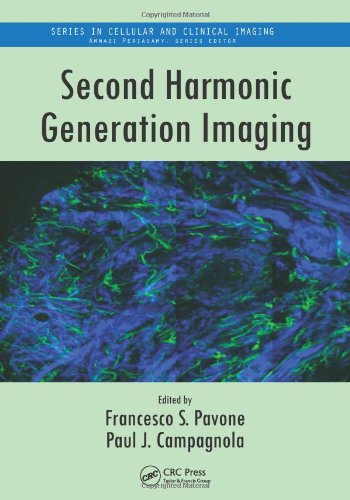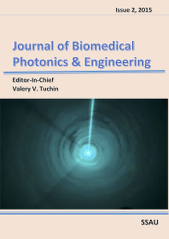Vol 1, No 4 (2015)
- Year: 2015
- Articles: 8
- URL: https://jbpe.ssau.ru/index.php/JBPE/issue/view/140
Introduction
Special Issue: Optical Technologies for Biomedical Applications
Abstract
We are pleased to present the fourth issue of JBPE, which focuses on optical technologies for study of biological tissues and fluids. These are selected papers presented at Saratov Fall Meeting 2015 – International Symposium on Optics and Biophotonics - III (September 22-25, 2015, Saratov, Russia).This issue includes 7 representative papers that well characterize the major topics of SFM-15.
More info in the PDF.
 208
208


Reviews
Integrated intravascular ultrasound and optical coherence tomography technology: a promising tool to identify vulnerable plaques [INVITED PAPER]
Abstract
Heart attack is mainly caused by the rupture of a vulnerable plaque. IVUS-OCT is a novel medical imaging modality that provides opportunities for accurate assessment of vulnerable plaques in vivo in patients. IVUS provides deep penetration to image the whole necrotic core while OCT enables accurate measurement of the fibrous cap of a plaque owing to its high resolution. In this paper, the authors describe the fundamentals, the technical designs and the applications of IVUS-OCT technology. Results from cadaver specimens are summarized, which indicated the complementary nature of OCT and IVUS for assessment of vulnerable plaques, plaque composition, and stent-tissue interactions. Furthermore, previously reported in vivo animal experiments are reviewed to assess the clinical adaptability of IVUS-OCT. Future directions for this technology are also discussed in this review.
 209-224
209-224


Articles
Biophysical approach to the correction of supporting tissue microcirculation impairments
Abstract
By experimental and histological methods it was estimated that application of terahertz –frequency electro-magnetic radiation at 150,176 – 150,664 GHz frequency at the background of acute and chronic immobilization stress contributes to the decrease of occurrence incidence of microcirculation impairments in the bone tissue and red bone marrow. The presented findings give the grounds to assume that terahertz –frequency electro-magnetic radiation at the frequency of molecular spectrum absorption and radiation of nitrogen oxide may be recommended as a valid and effective method in the complex treatment of patients with orthopedo-traumatological pathology.
 225-228
225-228


Assessing mechanical properties of tissue phantoms with non-contact optical coherence elastography and Michelson interferometric vibrometry
Abstract
Purpose: Elastography is an emerging method for detecting the pathological changes in tissue biomechanical properties caused by various diseases. In this study, we have compared two methods of noncontact optical elastography for quantifying Young’s modulus of tissue-mimicking agar phantoms of various concentrations: a laser Michelson interferometric vibrometer and a phase-stabilized swept source optical coherence elastography system. Methods: The elasticity of the phantoms was estimated from the velocity of air-pulse induced elastic waves as measured by these two techniques. Results: The results show that both techniques were able to accurately assess the elasticity of the samples as compared to uniaxial mechanical compression testing. Conclusion: The laser Michelson interferometric vibrometer is significantly more cost-effective, but it cannot directly provide the elastic wave temporal profile, nor can it offer in-depth information.
 229-235
229-235


Optical method for screening and a new proteinuria focus group
Abstract
The detection of small quantities of proteinuria has gained significance as multiple studies have demonstrated its diagnostic, pathogenic, and prognostic importance. More than 260 samples of urine taken from the patients suffering chronic kidney disease (CKD), diabetes and hypertension have been analysed in the certified laboratory, with urine analyser H-50 (urine test strips) and with an optoelectronic set-up specially designed for this study. Albumin, protein and creatinine concentrations have been determined in the laboratory and the data thoroughly analysed with the aim to find new approaches to tackle the lowered level proteinuria problems. Special attention has been paid to a particular screening focus group of 16 patients all having normal or slightly abnormal levels of albumin in parallel with enhanced levels of total protein (45% cases) up to 0.4 g/L. A fair correlation between the maxima in the protein, protein/creatinine, protein/albumin values and CKD in the focus group has been observed. The urine test strips method gave 94% negative false results for the focus group whereas the new sensor has shown in all cases the presence of proteins. The sensor signals higher than the mean in this focus group were obtained for the donors with the diagnosed CKD and some other diseases. The new method is based on the optical absorption measurements (285 nm) in the protein fractions received with use of the commercial desalting columns PD-10. The method can be applied in the wide region of protein concentrations from ≤0.1 g/L up to the levels of severe proteinuria (~10g/L).
 236-247
236-247


The stress-related changes in the cerebral blood flow in newborn rats with intracranial hemorrhage: metabolic and endothelial mechanisms
Abstract
 248-254
248-254


Software development for estimation of optical clearing agent’s diffusion coefficients in biological tissues
Abstract
The study of chemical diffusion in biological tissues is a research field of high importance and with application in many clinical, research and industrial areas. The evaluation of diffusion and viscosity properties of chemicals in tissues is necessary to characterize treatments or inclusion of preservatives in tissues or organs for low temperature conservation. Recently, we have demonstrated experimentally that the diffusion properties and dynamic viscosity of sugars and alcohols can be evaluated from optical measurements. Our studies were performed in skeletal muscle, but our results have revealed that the same methodology can be used with other tissues and different chemicals. Considering the significant number of studies that can be made with this method, it becomes necessary to turn data processing and calculation easier. With this objective, we have developed a software application that integrates all processing and calculations, turning the researcher work easier and faster. Using the same experimental data that previously was used to estimate the diffusion and viscosity of glucose in skeletal muscle, we have repeated the calculations with the new application. Comparing between the results obtained with the new application and with previous independent routines we have demonstrated great similarity and consequently validated the application. This new tool is now available to be used in similar research to obtain the diffusion properties of other chemicals in different tissues or organs.
 255-269
255-269


Statistical analysis of the parameters of the optic disk image
Abstract
In recent time much attention is payed to the computer analysis of the optic disc (OD) images, aimed at extracting the objective statistical characteristics of the OD image. In the present paper we describe a computer program that allows the determination of the mean colour indices, their variance, etc., for different regions of the OD. The total colour space in the RGB model is divided into subdomains in correspondence with the values of the mask that determines the subdomain boundaries. A simple method of determining the domain of the OD physiological excavation by the value of the variability coefficient is proposed.
 270-273
270-273











